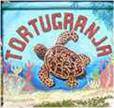Welcome to Casa Pastel
Your Home on Isla Mujeres!
ISLA MUJERES TROPICAL FAUNA From your front deck at Casa Pastel, you may spot dolphins and spotted rays leaping out of the water out at sea. They follow the schools of fish that fill the surf. The fish tend to stay closer to the deeper waters for safety, so it's harder to catch the impromptu dolphin shows, but once in a while you will see them close in. They are constant visitors to the reef and sharp eyes can catch them sailing through the air, farther away in the darker, deeper waters. Divers often get to visit with them in the open waters. From May to September the conservation and tourism sides of Isla Mujeres join together. The Caribbean near Isla Mujeres is famous for reef diving and snorkling, but the most unusual and impressive ecotours are our whale shark tours. For more information and list of operators who are allowed to guide you to swimming with whale sharks, check out http://www.isla-mujeres.net/waterfun.html
You've seen those large, dark seabirds floating by overhead on the Caribbean winds? They are frigate birds who are known to glide effortlessly in the air on autopilot for months without stopping. At left, the tall, stately white egret is a welcome ornamental visitor in the garden. They nest here in the winter months! The red-tailed ibis (middle) is another migrating visitor who makes Isla a stop on their route. Pelicans are year long residents who come to feed at the beach and raise their young. IGUANAS, GECKOS, AND OTHER REPTILES
You'll see iguanas roaming around Punta Sur, the beaches, in downtown Centro, and even in our backyard where "Iggy" our resident iguana, sleeps under the back stairs! Although looking for all the world like little dinosaurs, iguanas are normally docile and resemble Fido when offered food or water as they lap it up in appreciation. Sea turtle hatchlings are kept at secure hatching areas for later release when they are safer from natural predators. In late summer, the sea turtle nesting reaches a peak. These giant tortoises are endangered and the Caribbean islands are fighting hard to protect them. A crew of biologists and trained assistants patrol the beaches at night, watching out for mother tortoises digging nests in the sand. As the leathery, golf ball sized eggs drop into the nest they are colleced and moved to a safer space to hatch in the warm sand. In the past, the "Tortugranaja" or turtle farm, was used, but local funding issues caused the conservation groups to move the nests. One space at Half Moon beach in downtown Centro, is now a safely guarded hatching site. On the Gulf Coast and in the Caribbean region, sea turtles are a protected species. Nested along the beach, the eggs are favorite food for sea birds, iguanas, stray dogs and poachers who sell them on the black market. Every year we lose some of the female turtles to poachers who collect the eggs and the meat to sell. These creatures have been nesting here for millenia. A mature female produces well over 100 eggs when she nests. Although, there are not accurate records for individual turtles in the wild, we do know they can live to be well over 100!
Sadly, the answer is humans. The sandy shores where the turtles nest are expensive real estate. For decades, developers built hotels, condos, and homes along the shores for vacationers. When the mature turtles came back to their nesting grounds, there was no sand to nest. Private beaches did not allow random giant turtles to dig craters all over the beach. The habitat was destroyed and the turtles could not nest. The good news is that, with the efforts of local governments and many volunteers, these beautiful giants are making a comeback. It's a great feeling to be part of the solution!
To see a range of other colorful reptiles in the wild, take the walking path along the Caribbean shore in front of Casa Pastel. (You'll spot an entryway just down the main road by Margaritaville.) This leads to the Federal Zone, where everyone has free access to view the cliffs, the shore, flocks of seabirds, scampering iguanas and lizards - along with the island's priciest real estate. |

Visit Our Media Gallery

CASA PASTEL
Rates & Availability
We recommend Captain Tony and the Guadalupana crew for any water adventures on Isla. This is not a paid ad, he's just that good. We've gone with groups of family and friends from 5 years old to 75 and everyone has enjoyed the day.
 You can rent or bring your own googles and masks, but the fish that swim near the reef show up if you just take a walk in the water! You will see blue angelfish and dozens of other colorful species of tropical reef dwellers. (Some of them are curious enough to swim right up to you.)
You can rent or bring your own googles and masks, but the fish that swim near the reef show up if you just take a walk in the water! You will see blue angelfish and dozens of other colorful species of tropical reef dwellers. (Some of them are curious enough to swim right up to you.)


 Imagine an animal that lives for over a century and comes back to the beach where it hatched every year once it's mature to leave 100s of eggs in the sand to hatch and continue to make more baby turtles! You might ask yourself how these magnificent creatures came so close to extinction.
Imagine an animal that lives for over a century and comes back to the beach where it hatched every year once it's mature to leave 100s of eggs in the sand to hatch and continue to make more baby turtles! You might ask yourself how these magnificent creatures came so close to extinction.